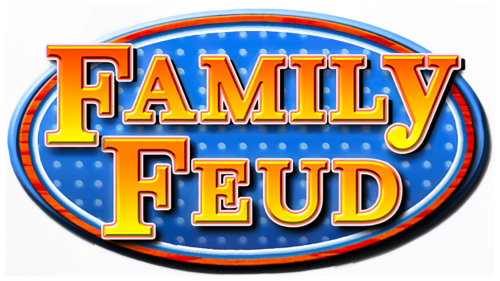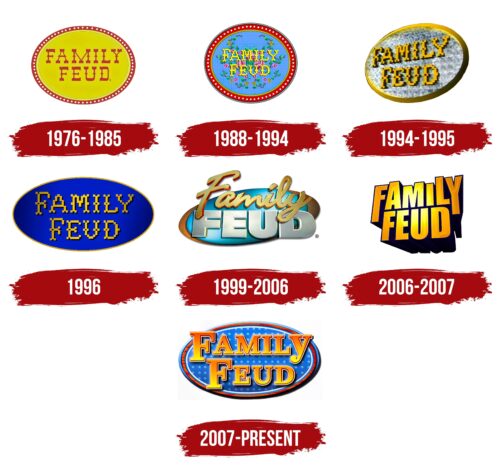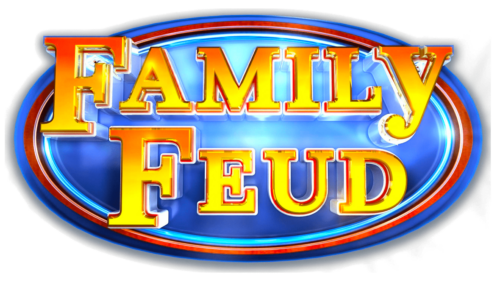The extraordinary Family Feud logo looks like the title screen of some Texan western. Originality and brightness are associated with the show’s theme, where the main goal is to snatch victory from opponents and demonstrate one’s guessing skills. The unique emblem emphasizes this feature and shows readiness to challenge anyone.
Family Feud: Brand overview
| Founded: | July 12, 1976 – present |
| Founder: | Mark Goodson |
| Headquarters: | United States |
| Website: | familyfeud.com |
Meaning and History
The name of the TV show originates from the concept of the game, in which a “feud” unfolds between families. Essentially, it is a competition with questions based on intuition, resourcefulness, and the ability to find a way out of unforeseen situations. There are no actual fights, so the word “feud,” in this case, is allegorical and somewhat provocative to attract attention and increase viewership.
The Family Feud logo also contains a touch of combativeness: in the early seasons, it was designed as a sign of a Wild West American tavern. This is evidenced by:
- Old English letters;
- A horizontal oval;
- A contrasting frame;
- An imitation of “stars” around the edge.
This style is purely American, as the emblem resembles the classic rondel – the basis for most antique signs. This is also emphasized by the palette – contrasting like the southern sky and dusty like sun-scorched earth.
What is Family Feud?
Family Feud is a television show that has been broadcast on American TV since 1976. It consists of three seasons. The essence of the show is a spectacular competition between two families. In the end, the winning participants are awarded prizes and receive money. The ideologist of the game is producer Mark Leo Goodson.
1976 – 1985
The emblem consisted of an ellipse with an inscription in the middle. The background inside was yellow, like the warm sun. The name of the TV show, written in an Old English font, stood out clearly on it. Each letter had expressive spikes that harmoniously blended with the large serifs. They balanced each other as the stems of the glyphs were thin. A strip of white dots ran around the edge of the oval, visually reminiscent of the classic frames with stars found on the seals of American institutions.
1988 – 1994
The emblem consisted of an oval flattened at the sides, which looked almost like a full circle. However, this impression was deceptive – the logo shape remained oval. A red frame with a series of white dots surrounded it. There was also an inner ring – beige, with a gradient color transition.
The central part looked like an embroidery canvas stretched on hoops. The designers visually rounded the oval for this purpose. As a result, the family TV show’s emblem accurately conveyed the idea of family. On the squared background, patterns were drawn: flowers, hearts, leaves, and other elements characteristic of embroidery. The most striking detail was the two-level inscription, stylized as a cross-stitch embroidery.
1994 – 1995
The Family Feud logo was distinctly oval. It got a yellow frame and an inscription that looked pixelated or as if made of Lego pieces. Each letter was accompanied by blurred shadows, making the name appear voluminous. The background was a white-gray ornament. The glyphs had spikes and ornate serifs, making them resemble the characters of the Old English alphabet.
1996
The pixelated style of the emblem was preserved, although some details completely changed during the redesign. For example, the color palette shifted to a muted red spectrum: the letters were written in dark maroon, and the background had a carrot hue.
1999 – 2006
With the arrival of the third season of the TV show, there was a radical change in its visual identity. Designers tilted the oval to the left, noticeably lifting the right side, and colored it in azure with a gradient. They added a golden frame around the edges. It had an uneven width, which brought dynamism to the logo. Above it, the name of the show was displayed in a playful style: the word “Family” was italic and handwritten, while “Feud” was blocky and business-like.
2006 – 2007
The Family Feud emblem designers settled on a block style. To do this, they turned both parts of the title into large characters. Despite their bulk, the inscriptions were perceived easily and dynamically because the letters were of different heights. The designers abandoned the oval and placed the text on a white background, making it appear to float in the air. Black shadows added volume, and a glare in the center brought brightness.
2007 – today
The oval and small dots have returned to the logo, which is now not on the edge, but in the middle, acting as a patterned background. They look like tiny LED lights. The designers made the frame triple: the strip closer to the center is painted white, the middle one is dark sandy with a wood texture, and the furthest one is blue, like the center. The right and bottom sides of the ellipse are decorated with a smoky shadow, making the geometric figure appear to be hanging in the air.
The TV show’s title is placed on graphic elements. It is much larger than the image, so the side letters protrude beyond its borders. The inscription is a gradient – brick-gold. All glyphs are uppercase except for the lowercase “y,” which is simply enlarged in size.
Font and Colors
The Family Feud logo uses a typeface derived from the Clarendon Bold font, created in 1953 by Hermann Eidenbenz. The glyphs with serifs resemble Akzidenz-Grotesk ExtraBold.
The emblem’s color palette is diverse. It includes several shades of red, gold, silver, white, blue, and azure. In addition, there are a lot of gradients, conveying the inner energy of the sign.
Family Feud color codes
| Azure | Hex color: | #0479ef |
|---|---|---|
| RGB: | 4 121 239 | |
| CMYK: | 98 49 0 6 | |
| Pantone: | PMS 2727 C |
| Canary Yellow | Hex color: | #fff100 |
|---|---|---|
| RGB: | 255 241 0 | |
| CMYK: | 0 5 100 0 | |
| Pantone: | PMS 3955 C |
| Mystic Red | Hex color: | #fe5400 |
|---|---|---|
| RGB: | 254 84 0 | |
| CMYK: | 0 67 100 0 | |
| Pantone: | PMS Orange 021 C |
| Black | Hex color: | #06080c |
|---|---|---|
| RGB: | 6 8 12 | |
| CMYK: | 50 33 0 95 | |
| Pantone: | PMS Black 6 C |













